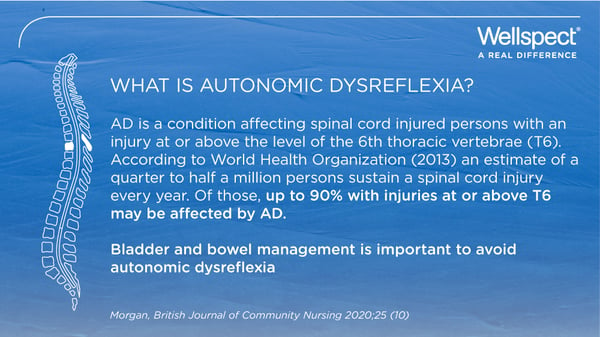Autonomic dysreflexia (AD) is a condition that may affect as many as 90% of spinal cord injured patients with injuries at or above the 6th thoracic vertebrae. This review aims to increase the knowledge and understanding of AD to ease management of the condition.

In this review, the author describes the prevalence, cause, symptoms, assessment and management of autonomic dysreflexia (AD). A spinal cord injury at or above the 6th thoracic vertebrae may cause AD in up to 90% of the cases. AD is an episodic uncontrolled elevation of systolic blood pressure of more than 20 mmHg that is caused by a noxious stimulus below the level of injury. A noxious stimulus can be a distended bladder or constipation and it is therefore important to have a good bladder and bowel management in place.
Healthcare professionals meeting persons with a spinal cord injury need to have the knowledge and understanding of AD to be able to identify and react quickly to prevent further complications such as seizures and intracranial hemorrhage. The main symptoms of AD are:
- Elevated blood pressure
- Pounding headache
- Bradycardia
- Profuse sweating above the level of injury
- Goose bumps above or possibly below the level on injury
- Cardiac arrhythmias
- Flushing of the skin
- Blurred vision
- Nasal congestion
If a dysreflexic crisis occur, assessment can be made according to the ABCDE-tool:
- A-Airways
- B-Breathing
- C-Circulation
- D-Disability
- E-Exposure
A dysreflexia crisis is an acute condition requiring immediate treatment or emergency transfer. First line treatment is considered to be non-pharmacological treatment, in persons who are not displaying severe hypertension, and removal of noxious stimuli is often enough to reduce the AD response. It is important that education and information is received by both the AD affected persons and the consulting healthcare professional to enable long-term management as well as self-management techniques.
If you want to know more about this condition download the summary of this article below.




